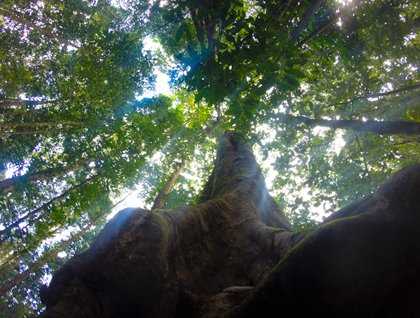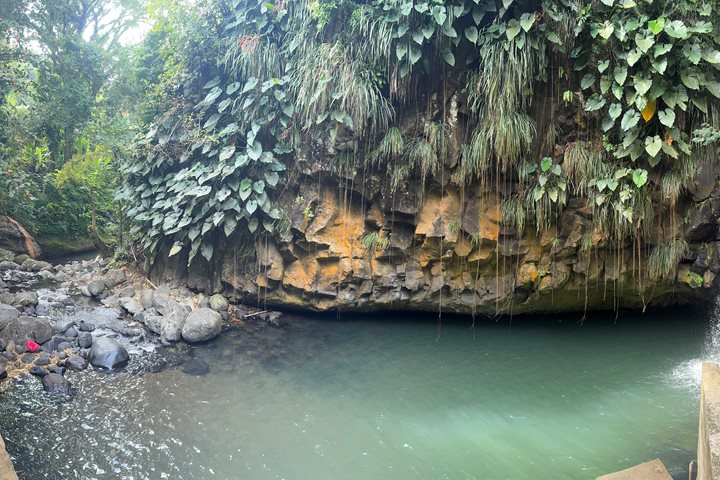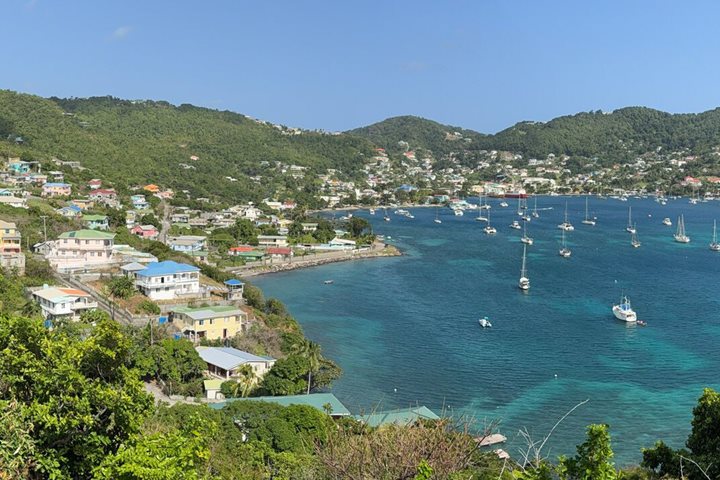We sailed into the beautiful Prince Rupert Bay on the island of Dominica at 6:30 a.m. and were docked at Cabritsheadland at 7:10 a.m. The sun rose over the great Mountain of Morne Diaboltin and floodlit the lush proliferation of greens on the island. This island is the most mountainous of all the Windward Islands. Morne Diaboltin is approximately 4800 feet above sea level. Dominica has the highest concentration of active volcanoes anywhere in the earth -- nine active volcanoes in an area slightly less than 300 square miles. The mountainous spine of Dominica sits atop a vast molten lava chamber.
After breakfast we took the 45-minute scenic ride to the Morne Diaboltin rain forest. They receive some 30’ of rain a year and it did rain for a few minutes on the way but not thankfully while we walked through the forest. We passed breadfruit, mangoes, bananas, pineapples, manioc, yam, coffee, oranges and grapefruit trees in a wild profusion. Dominica is indeed the “nature island.” During our walk we saw a wealth of tropical trees with the most colorful creole names, e.g., Bwa Kaka meaning the “tree of smells.” My group was lucky enough to see the indigenous parrot called “Jacko,” with its beautiful green and red plumage and a “bouquet” of hummingbirds, mostly the Blue Headed Antillean. Just before we emerged from the rich green gloom of the rainforest I spotted a zandolin sunning itself on a tree. This is one of the species of lizards that lives on the island.
We returned to the Sea Cloud for lunch and immediately afterwards I gave an introductory talk on Dominica and Fort Shirley. The fort was begun in 1774 and not fully completed until 1820. It was built almost entirely by slave labor. The fort is strategically situated on Cabrits headland. Designed by the 18th century American architect William Harrison to protect the Royal Navy at anchor in Prince Rupert Bay, the fort never saw action and existed principally as a deterrent to enemies of the English as the canons could sweep the entirety of Prince Rupert Bay. At its zenith the fort had 700 enlisted men and a contingent of the 8th West Indian Regiment made up of slaves. The French forces under Admiral DeBouille took Dominica in September of 1778 only to lose it again in the Treaty of Paris of 1783. The Fort was abandoned in 1852 and lay derelict and in ruin covered by strangler figs and the wrath of the jungle until Dr. Lennox Honeychurch undertook restoration beginning in 1982. As we were up on the fort, Tom O’Brien called me on the radio and reported that some of our guests saw a humpback whale in the bay.
After our visit to Fort Shirley we went snorkeling in the protected marine sanctuary directly next to where we were docked. Mike Greenfelder led the snorkelers. This is a wonderful place to see a variety of colorful fish, parrotfish, grunts, wrasse, trumpet fish and a variety of corals from fan, and elkhorn to large barrel corals.
We sailed from the dock at 5:15 p.m. and anchored in the bay where we had a splendid dinner on the Lido Deck. I went to bed fully satisfied and looking forward to our visit to Iles des Saintes tomorrow.









